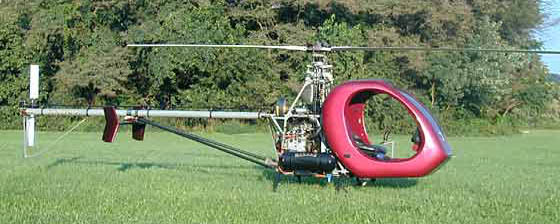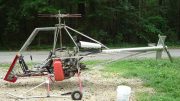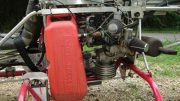Bob Kinney’s Hot Rod Helicopter Plans

Bob Kinney’s Scratch Built Hot Rod Helicopter (HRH)
Designer and builder Bob Kinney completed this experimental hot rod helicopter in one year, one month, one week, and one day.
The intention was to build a solid, cross country capable single seat helicopter from commonly available industrial and auto parts without the need for complex machining. It also had to be easy to maintain and inspect for pre-flights.
Bob named his helicopter the “Kinney HRH” (Hot Rod Helicopter) because of the lack of doors and hood, much resembling the desirable aspects of the automotive hot rod of days past – and no, Diane (wife), I won’t fall out, I promise! – The air cleaner is from a dual quad set-up; many of the parts used to built the helicopter came from the local auto parts store or were mail-ordered from speed-shop catalogues.
Here are some of the hot rod helicopters key features.
▣ The helicopter design uses a four-stroke Subaru EJ22 engine with multiport fuel injection. (believed to have later changed to the more powerful EJ25 engine)
▣ The tail rotor is shaft-driven (with commercially available right angle gearbox), and the open engine bay design makes pre-flight inspection easier.
▣ The counter clockwise rotation of the composite Waitman rotor blades makes it easy for those use to standard American helicopters to transition to the Kinney design Hot Rod Helicopter.
▣ True swift comfortable long range cross country performance in solid composite cabin – with a real helicopter feel.
▣ The hot rod helicopter airframe is constructed of thick wall aircraft grade 4130 chromoly steel, and the pod is made of hand laid fiberglass.
▣ An advanced control panel with digital engine management instruments.
Bob Kinney had a number of objectives in mind when he designed the helicopter. He wanted to make a relatively inexpensive single-place helicopter. He wanted it to have reliable four-stroke power, and a tail-rotor driven by a shaft. Basically he wanted what we all have been wanting – but not getting with designs such as the Rotorway Exec and AW95 helicopters.
He also wanted the hot rod helicopter to be economical to operate (it runs on unleaded auto gasoline) and to have low maintenance, with low-cost replacement parts. He wanted it to be durable and reliable, and “fun, fun, fun” to fly. Bob also wanted the helicopters dimensions to be such that it could be “stored” in his garage.
| HOT ROD HELICOPTER SPECIFICATIONS | |
|---|---|
| Length | 20 ft |
| Height | 7.25 ft |
| Width (Skids) | 5.55 ft (175cm) |
| Main rotor diameter | 25 ft |
| Rotorblade Type | Waitman composite |
| Main rotor chord | 8 inches |
| Main rotor RPM | 520 |
| Tail rotor diameter | 46 inches |
| Tail rotor chord | 4.5 inches |
| Tail rotor rpm | 2900 |
| Empty weight | 1000 lbs |
| Useful load | 350 lbs |
| Gross weight | 1350 lbs |
| Speed (max) | 103 mph |
| Speed (cruise) | 80-90 mph |
| VNE | 115 mph |
| Engine | Subaru EJ25 |
| Horsepower | 165 |
| Flight duration | 2 hrs |
| Fuel capacity | 18.5 gallons |
| Max Altitude (est.) | 10,000 ft |
| HIGE (est.) | 7000 ft |
| HOGE (est.) | 5000 ft |
Well, Bob was able to meet most of these design objectives, though not all. He was indeed able to get the helicopter into his garage, but to do so he has had to fit his car under the tail boom (thankfully it’s a very, very low sports car), and he does have to take the main rotor blades off in order to get the doors closed.
Also, although initially the objective had been to keep the empty weight to about 700 pounds, the hot rod helicopter ended up weighing a little over 1000 lbs (Bob accepted a little more weight in order to increase safety). As with most helicopter prototypes, they can be improved upon with following models. There are many places, including the airframe, cabin and engine, where weight could be reduced while retaining acceptable safety margins.
Overall, Bob is quite happy with the way it all turned out, and this Summer he plans to take the hot rod helicopter to Homer Bells, Mentone, and to Oshkosh. To date, he has flown the helicopter in ground effect, and all seems very promising – (UPDATE: has now flown all flight parameters with ease!).

Bob Kinney and his helicopter award
The first flight was conducted on April 8th by Charlie Lavens, who has been flying helicopters since 1984. Charlie Lavens, who owns Cal Manufacturing in Illinois (where he does aviation and small-run production of all types, including aluminum castings, lathe and mill work, etc.) did all the castings and machining on the swash plate assembly (basically similar to the Rotorway Exec helicopter) and made the main rotor shaft.
Don Parham (Subaru engine conversion expert) of RFI, in Indianola, OK., made some of the helicopters drive-line parts, the aluminum flywheel, and the thrust plate and pulleys. Most of the other machining was done at Park Hill Machine, inc., in Lancaster, PA. (Bob’s hometown).
Phil Toews worked very closely with Bob doing the project’s machining over a number of months, making high-quality parts: the whole crew at Park Hill just did a great job! To these people, and to everybody else who helped along the way to getting the helicopter to its first flight, Bob expresses his most sincere appreciation!

Kinney experimental single seat personal helicopter
EDITORS NOTE: Bob has since put MANY flight hours on his original design HRH (Hot Rod Helicopter) and has since sold on the distribution rights for the HRH helicopter plans to Vortech who now market and distribute on his behalf.
A full Hot Rod Helicopter flight demonstration video is available for sale along with a few different plans/blueprint options.
While these helicopter plans give a great amount of information and detail for its construction, they shouldn’t be considered “complete” as there is some important and essential detail missing – but it can be worked through with relative ease.
Also while there are sources for commercial main rotor gearbox substitutes, the HRH uses a converted drive transmission (differential) from a vehicle that may not be available in your region though similar units can be used. The swash plate assembly is basically the Rotorway Exec as is the main rotorhead – the rotor blades appear to be SkyWheels, now made by Canadian Home Rotors for the Safari kit helicopter.
VIDEO: Bob Kinney Hot Rod Helicopter (HRH) Plans Built Helicopter
DO NOT USE GMAIL OR YAHOO ACCOUNTS TO ORDER THESE PLANS! – 1. Gmail and Yahoo blocks our server, why? we do not know. 2. Gmail and Yahoo limits the size of the download, so we cannot send it manually! 3. Gmail and Yahoo blocks our email address or places it in your spam folder – so we have NO WAY of communicating with you or responding to your emails.











i want to make one kit heli